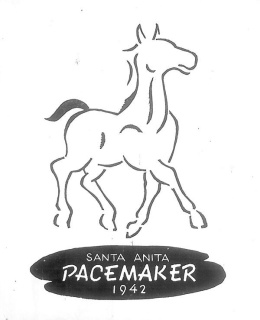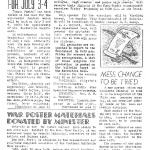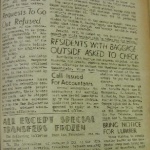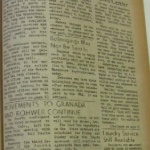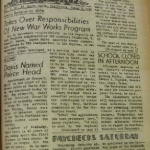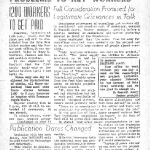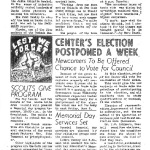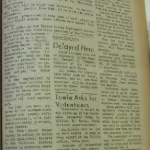Santa Anita Pacemaker (newspaper)
| Publication Name | Santa Anita Pacemaker |
|---|---|
| Camp | Santa Anita (detention facility) |
| Start of Publication | April 18, 1942 |
| End of Publication | October 7, 1942 |
The Santa Anita Pacemaker was one of fifteen newspapers published in temporary detention camps euphemistically called assembly centers and administered by the Wartime Civil Control Administration . Debuting on April 18, 1942, the Pacemaker was the longest running of the purely "assembly center" papers and served the temporary camp with the largest population. Its core editorial staff remained the same throughout its run, led by editor Eddie Shimano .
The Santa Anita paper debuted on April 18, 1942, soon after the camp opened on March 27. The first issue was unnamed, the masthead consisting of question marks, with readers asked to suggest names for the paper. [1] By issue two, dated April 24, the "Pacemaker" name—a nod to the camp's horse racing track origins—had been selected. The paper published a four page edition twice a week, on Tuesdays and Fridays. As the center's population grew and as the paper became more established, it moved to six pages per issue on June 19, also changing its publication schedule to Wednesdays and Saturdays. Eight page issues would commence on August 15. The circulation of the first issue was 1,800; it would rise to 5,000 by June. [2]
The editorial staff, led by editor Shimano, was very stable, with the core group that included managing editor Kaz Oshiki, news editor Paul Yokota, art editor Roy Kawamoto, and circulation manager James T. Eno serving in those capacities for all or almost all of the run of the paper. City editor Joe Oyama and recreation editor Bob Hirano came on board on May 12 and women's editor Asami Kawachi on May 26. Each issue included Shimano's column titled "Win, Place and Show" that consisted of short bits of center news. Later, Kawachi's "Feminine Forum" column became a regular feature, as did sports editor Hiroshi Ito's "Santa Anita Post Time."
As with other newspapers published in the temporary detention camps, the Pacemaker operated under strict guidelines. The Japanese language was prohibited and copy in the paper had to be approved multiple times by camp administrators. (See Newspapers in camp .) As such, the paper takes on what seems to be an artificially cheery demeanor for a publication that is serving what is effectively a concentration camp. Much of the paper's copy includes information provided by camp administrators including rules, important information, notices, and warnings. The May 1 issue, for instance, includes rules regarding fire prevention as well as a report on the spate of power outages ostensibly caused by inmates' using lightbulbs with larger wattages than the approved forty or plugging in other appliances, concluding that these practices should be stopped, quoting from an administration bulletin. [3] Later, the paper strongly promotes elections for "self-government," a June 2 editorial praising the election, emphatically stating "This is Democracy in action!" [4] There were also several articles devoted to presenting the administration's views on the controversial camouflage net project housed at the center. The project—which involved inmates working to produce camouflage nets for use by the army—resulted in a sit-down strike involving some 800 workers, an incident that is not directly noted in the paper. [5] The early August unrest at the camp (often referred to as a "riot") resulted in the August 5 issue not appearing and ultimately being combined with the August 8 issue. A brief article on the "inspection disturbance" noting the withdrawal of the military police appears in what is otherwise a normal issue. [6]
The bulk of the paper covered the everyday happenings at a camp with nearly 20,000 people. There were birth, death and wedding announcements; notices for various types of social gatherings including dances, craft shows, church services, movies, and the gala "Anita Funita" carnival on July 3–4; and much space devoted to the variety of sports and recreation activities from softball to boxing to sumō . Later issues featured a literary section (dubbed the "Magazine Section") that included prose and poetry by center inmates. Human interest stories dotted the paper, from "Woman, 83, Performs Many Athletic Feats" to a story on the residents of stall where the famed racehorse Seabiscuit had lived. [7]
An undated twenty-eight page farewell issue included a message from Carey McWilliams , along with final columns by Shimano, Kawachi, and Ito. A story on the paper itself proudly cites favorable notices it received from mainstream papers such as the Los Angeles Times and San Francisco News as well as requests for issues from the Library of Congress, New York Public Library and many other mainstream institutions. [8]
The 50th and last issue of the Pacemaker was dated October 7, 1942. The Santa Anita Assembly Center closed on October 27. Shimano, Yokota, and the Oyamas (Joe Oyama and Asami Kawachi were married at Santa Anita) all went on to play roles in the Denson Communique and Tribune newspapers after they moved to the Jerome , Arkansas, War Relocation Authority camp.
For More Information
Digitized issues of the Pacemaker are available in the Densho Digital Repository ( http://ddr.densho.org/ddr-densho-146/ ) and at the City of Arcadia website ( http://www.ci.arcadia.ca.us/home/index.asp?page=1565 ).
Girdner, Audrie, and Anne Loftis. The Great Betrayal: the Evacuation of the Japanese-Americans during World War II . London: Macmillan Co., 1969.
Footnotes
- ↑ PY [Paul Yokota], "Records of a Curious Interval," Santa Anita Pacemaker 1942, 20–21, accessed online on June 13, 2012, http://library.ci.arcadia.ca.us/SAJAC/SantaAnitaPacemaker1942.pdf .
- ↑ "Pacemaker, Leader in Democracy," Santa Anita Pacemaker , June 2, 1942, 2. Accessed online on June 13, 2012, http://library.ci.arcadia.ca.us/SAJAC/SantaAnitaPacemaker1942.pdf .
- ↑ Santa Anita Pacemaker , May 1, 1942, 1, 2, accessed online on June 13, 2012, http://library.ci.arcadia.ca.us/SAJAC/05-01-1942.pdf .
- ↑ "Pacemaker, Leader in Democracy."
- ↑ See for instance "Amory Explains Camouflage Problems to Net Workers," Santa Anita Pacemaker, June, 19, 1942, 1, accessed online on January 16, 2017, http://ddr.densho.org/ddr-densho-146-19/ .
- ↑ Santa Anita Pacemaker," August 5 and 8, 1942, accessed online on January 16, 2018 at http://ddr.densho.org/ddr-densho-146-35/ .
- ↑ "Woman, 83, Performs Many Athletic Feats," Santa Anita Pacemaker , May 22, 1942, 2, accessed online on July 16, 2017, http://ddr.densho.org/ddr-densho-146-9/ ; "They Didn't Know Seabiscuit Once Lived There," Santa Anita Pacemaker , June 3, 1942, 1, accessed online on July 16, 2017, http://ddr.densho.org/ddr-densho-146-14/ .
- ↑ Yokota, "Records of a Curious Interval."
Last updated June 9, 2020, 6:01 p.m..

 Media
Media
